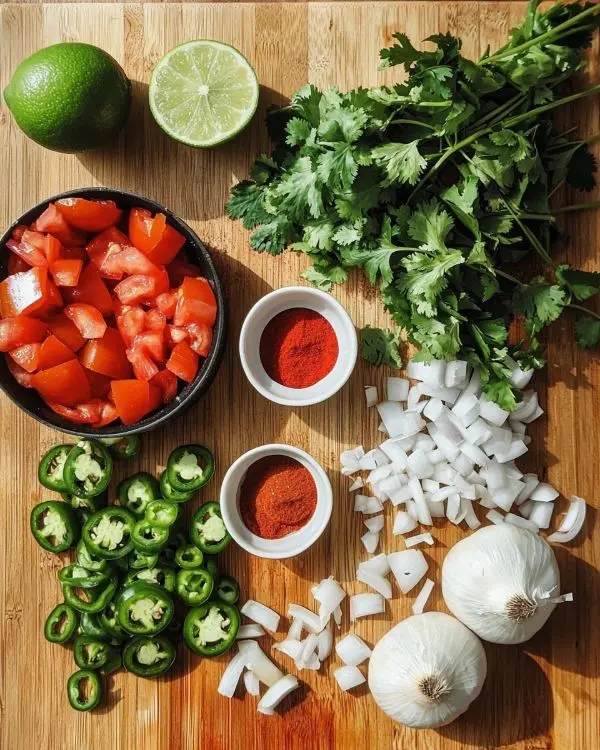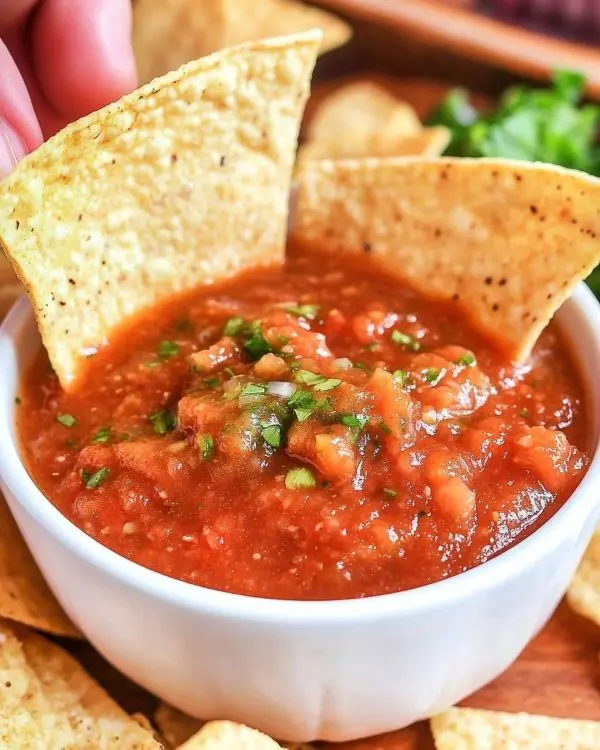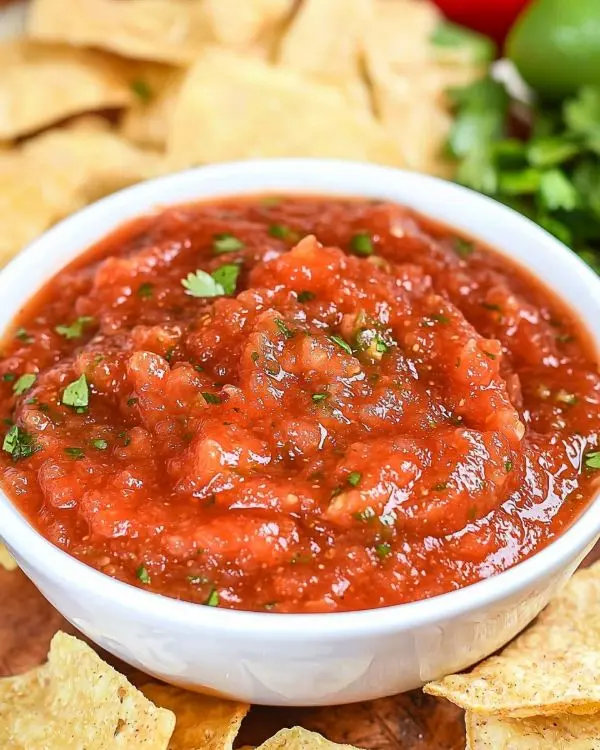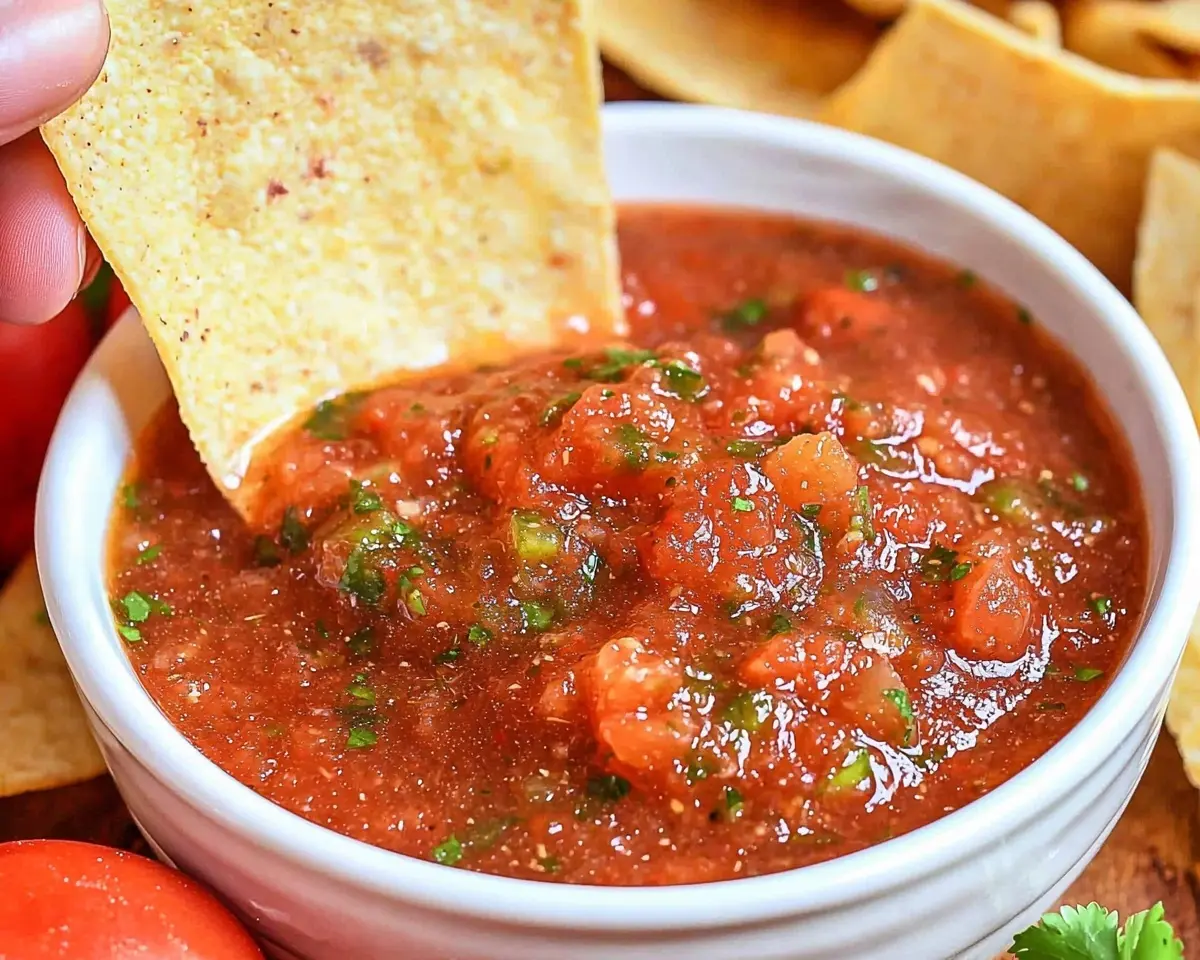Homemade salsa recipe delivers restaurant flavor fast. Fire-roasted tomatoes create authentic Chili’s copycat salsa texture every time.
Hi, I’m Linda, and welcome to Tasty at Home—where bold flavors meet everyday kitchens. One disappointing jar of store-bought salsa changed everything for me. Additionally,
I remember standing in my Phoenix kitchen on a sweltering July afternoon, staring at that bland, watery mess I’d just opened. Meanwhile, my neighbor Maria was making fresh salsa next door, and the aroma of roasted tomatoes and cilantro drifted through our shared fence.
That moment sparked my three-year journey to perfect this homemade salsa recipe. Moreover, I’ve tested dozens of variations—some too chunky, others too smooth, and a few that were complete disasters.
Furthermore, I burned through two blenders and learned that fresh tomatoes don’t always deliver the consistency you want.
However, this fire-roasted version finally cracked the code. In fact, it tastes exactly like the salsa from your favorite Mexican restaurant. Therefore, whether you’re hosting a Super Bowl party or just want Tuesday night tacos to shine, this recipe delivers every single time.
Table of Contents
What Makes This Homemade Salsa Recipe Extraordinary
This isn’t just another basic salsa recipe. Instead, it’s a carefully crafted blend that mimics the depth and complexity of professional restaurant versions. Specifically, the secret lies in using fire-roasted canned tomatoes rather than fresh ones.
Fire-roasted tomatoes provide consistent flavor year-round. Additionally, they deliver that smoky depth that makes restaurant salsa so addictive. Furthermore, the canning process concentrates the tomato flavor, eliminating the watery texture that plagues many homemade versions.
Core Ingredients That Build Flavor of Homemade Salsa Recipe

| Ingredient | US Measure | Metric | Purpose |
|---|---|---|---|
| Fire-roasted canned tomatoes | 28 oz | 794g | Base with smoky depth |
| White onion | 1/2 medium | 75g | Sharp bite and crunch |
| Jalapeño peppers | 2 whole | 30g | Controlled heat level |
| Garlic cloves | 2 large | 8g | Aromatic foundation |
| Fresh lime juice | 1 lime | 30ml | Bright acidity |
| Fresh cilantro | 1/3 cup | 20g | Herbaceous freshness |
| White granulated sugar | 1/2 tsp | 2g | Balances acidity |
| Salt | 1 tsp | 5g | Flavor enhancer |
| Ground cumin | 1 tsp | 2g | Earthy warmth |
| Chipotle chili powder | 1/2 tsp | 1g | Smoky heat |
Shopping Tips for Perfect Results
First, look for fire-roasted tomatoes in the canned goods aisle near regular diced tomatoes. Additionally, Hunt’s and Muir Glen offer excellent options. Moreover, if you can’t find fire-roasted, regular diced tomatoes work but lack that signature smoky flavor.
Choose firm jalapeños with smooth, unblemished skin. Furthermore, the heat level varies dramatically between individual peppers. Therefore, start with less and add more to taste. Meanwhile, white onions provide the sharpest bite, though yellow onions work as substitutes.
Fresh cilantro should have bright green leaves without yellowing. Similarly, avoid bunches with slimy or darkened stems. Also, store cilantro like fresh flowers—trim the stems and place in water.
Bold Add-ins and Creative Variations
Transform this base recipe with these exciting additions:
Smoky Heat Boost: Add one chipotle pepper in adobo sauce for deeper smoke flavor. Additionally, this creates an authentic Chili’s copycat salsa profile.
Fresh Garden Style: Substitute 2 pounds ripe tomatoes for canned versions during peak summer season. However, you’ll need to drain excess liquid for proper consistency.
Sweet Heat Balance: Include 1 tablespoon finely diced red bell pepper. Moreover, this adds sweetness and beautiful color contrast.
Essential Equipment and Preparation
Equipment You’ll Need
A quality blender or food processor makes this recipe effortless. Additionally, a standard blender works perfectly for this quantity. However, if you only have a small personal blender, work in two batches.
Furthermore, you’ll need a sharp chef’s knife for prep work. Also, keep a cutting board, measuring cups, and a large mixing bowl handy. Meanwhile, a fine-mesh strainer helps if you prefer thinner consistency.
Step-by-Step Homemade Salsa Preparation
Step 1: Prep Your Vegetables (5 minutes)
First, drain the fire-roasted tomatoes in a colander. Additionally, reserve about 1/4 cup of the liquid—you might need it for consistency adjustments. Meanwhile, this step prevents watery salsa.
Next, rough chop the onion into quarters. Similarly, remove stems from jalapeños but keep seeds for heat. Also, peel garlic cloves and give them a gentle smash with the flat side of your knife.
Step 2: Juice Your Lime Properly (2 minutes)
Roll the lime firmly on your counter before cutting. Additionally, this breaks down internal membranes and releases more juice. Furthermore, microwave the lime for 10 seconds if it’s cold from the refrigerator.
Cut the lime in half and squeeze through a fine-mesh strainer. Moreover, this catches seeds while allowing pulp to pass through. Therefore, you get bright flavor without bitter seed oils.
Step 3: Blend to Perfect Consistency (3 minutes)
Add tomatoes to your blender first. Additionally, this creates the liquid base that helps other ingredients blend smoothly. Furthermore, add onion, jalapeños, and garlic next.
Pulse 3-4 times for chunky texture. However, avoid over-processing—you want recognizable pieces, not a smooth puree. Meanwhile, taste and adjust heat level by adding more jalapeño if needed.
Pro Tip from My Testing Kitchen: I learned this the hard way after making salsa soup instead of chunky goodness. Therefore, always pulse rather than blending continuously.
Step 4: Season and Balance Flavors (2 minutes)

Add lime juice, cilantro, sugar, salt, cumin, and chipotle powder. Additionally, pulse 2-3 more times to incorporate seasonings evenly. Furthermore, taste and adjust salt levels—this makes or breaks your final flavor.
The sugar isn’t for sweetness—it balances the natural acidity in tomatoes. Moreover, this technique comes from chef Rick Bayless’s authentic Mexican cooking methods.
Step 5: Rest and Serve (Optional but Recommended)
Let the salsa rest for 15 minutes before serving. Additionally, this allows flavors to meld and develop complexity. Furthermore, the salt draws out additional moisture, concentrating flavors.
Expert Tips for Restaurant-Quality Results
Consistency Control Methods
Too Thick: Add reserved tomato liquid one tablespoon at a time. Additionally, a splash of lime juice thins while adding brightness.
Too Thin: Strain through a fine-mesh colander for 10 minutes. Moreover, you can add a pinch of tomato paste for thickening without diluting flavor.
Perfectly Chunky: Pulse in 2-3 second intervals. Furthermore, check consistency between pulses to avoid over-processing.
Heat Level Management
Start conservatively with jalapeños. Additionally, you can always add more, but you can’t remove heat once it’s blended. Moreover, the white pith and seeds contain most of the capsaicin.
For mild salsa, remove all seeds and pith. However, for medium heat, include seeds from one pepper. Furthermore, for hot salsa, include everything plus an extra jalapeño.
Temperature Testing Trick: Dab a small amount on your wrist—if it tingles there, it’ll be perfect on your tongue.
Creative Variations That Wow your Homemade Salsa Recipe
Chevy’s Copycat Salsa Style: Add 1/2 teaspoon oregano and increase cumin to 1 1/2 teaspoons. Additionally, this creates that distinctive restaurant chain flavor profile.
Smoky Chipotle Version: Replace regular chili powder with additional chipotle powder. Moreover, add one minced chipotle pepper in adobo for authentic smokiness.
Fresh Garden Summer Salsa: Use 2 pounds ripe tomatoes, seeded and diced. However, salt them for 30 minutes and drain before blending. Furthermore, this prevents watery texture.
Holiday Cranberry Salsa: Add 1/4 cup dried cranberries and 1 diced apple. Additionally, this creates a festive twist perfect for Thanksgiving appetizers.
Tropical Mango Fusion: Include 1/2 cup diced fresh mango and substitute orange juice for half the lime juice. Moreover, this pairs beautifully with grilled fish tacos.
Storage and Make-Ahead Strategy
| Storage Method | Duration | Notes |
|---|---|---|
| Refrigerated (sealed) | 5-7 days | Peak freshness first 3 days |
| Frozen (ice cube trays) | 3 months | Portion control for recipes |
| Canned (water bath) | 12 months | Requires proper canning technique |
Store in glass jars rather than plastic containers. Additionally, glass doesn’t absorb flavors or odors. Furthermore, wide-mouth mason jars make serving easier.
Make-Ahead Magic: Prepare ingredients up to one day ahead, but blend just before serving. Moreover, this maintains optimal texture and prevents separation.
Homemade Salsa Recipe Perfect Pairing Suggestions
This homemade salsa shines with homemade chili seasoning mix for Tex-Mex nights. Additionally, it’s essential for award-winning crockpot chili recipe garnishing.
Serve alongside Mexican street tacos for authentic flavor combinations. Furthermore, it elevates copycat Taco Bell Mexican pizzas to restaurant quality.
For creative applications, try it with Chile relleno quesadillas or as a soup garnish for classic chili.
Homemade Tortilla Chips: The Perfect Companion

Fried Tortilla Chips Method
Use small corn tortillas and cut them into quarters. Additionally, this size provides perfect chip-to-salsa ratios. Furthermore, corn tortillas offer authentic flavor and better crunch than flour versions.
Heat 2 cups vegetable oil to 350°F in a heavy skillet. Moreover, use a thermometer for accuracy—too hot and chips burn quickly. Meanwhile, set up a wire rack over a baking sheet lined with paper towels.
Fry tortilla pieces in small batches for 2-3 minutes per side. Additionally, use metal tongs to flip halfway through cooking. Furthermore, avoid overcrowding, which drops oil temperature and creates soggy chips.
Baked Tortilla Chips Alternative
Preheat oven to 350°F and arrange cut tortillas on a large metal baking sheet. Additionally, avoid overlapping for even cooking. Moreover, lightly spray with cooking oil for extra crispiness.
Bake for 5-6 minutes, then flip each chip individually. Furthermore, bake another 6-8 minutes until golden and crispy. However, watch closely during the final minutes to prevent burning.
Season immediately with salt while chips are still hot. Additionally, this helps seasoning adhere better than waiting until they cool.
Chili’s Copycat Salsa FAQs
What are the ingredients for salsa?
Traditional salsa contains tomatoes, onions, peppers, cilantro, lime juice, and salt. Additionally, this homemade salsa recipe includes cumin and chipotle powder for restaurant-style depth. Moreover, fire-roasted tomatoes provide superior flavor compared to fresh varieties.
What is the secret ingredient in homemade salsa?
The secret ingredient is fire-roasted canned tomatoes instead of fresh ones. Additionally, the small amount of sugar balances natural acidity without adding sweetness. Furthermore, letting flavors rest before serving allows ingredients to meld perfectly.
What are the 6 ingredients in salsa recipe?
The essential six ingredients are tomatoes, onions, jalapeños, cilantro, lime juice, and salt. However, this enhanced version includes cumin and chipotle powder for restaurant-quality flavor. Moreover, garlic and sugar create additional complexity.
How to make salsa easy?
Use a blender or food processor for quick preparation. Additionally, pulse ingredients rather than blending continuously for perfect chunky texture. Furthermore, fire-roasted canned tomatoes eliminate the need for roasting fresh ones. Therefore, total preparation time stays under 10 minutes.
Final Thoughts: Your New Go-To Salsa Recipe
This homemade salsa recipe transformed my kitchen from ordinary to extraordinary. Additionally, it’s become my most-requested contribution to potlucks and parties. Moreover, the consistent results mean you’ll never face salsa disappointment again.
The beauty lies in its simplicity and reliability. Furthermore, you can customize heat levels and add creative variations while maintaining that signature restaurant flavor. Therefore, whether you’re making cowboy queso or simple chips and salsa, this recipe delivers.
Remember that humid Phoenix afternoon when I discovered the power of homemade salsa? Additionally, this recipe represents three years of testing, tasting, and perfecting. Moreover, it’s proven itself through countless game days, family gatherings, and Tuesday night taco emergencies.
Grab your blender and give this recipe a try tonight. Furthermore, tag us on social media with your creations—we love seeing how this recipe becomes part of your family traditions. Therefore, get ready to experience salsa that rivals your favorite Mexican restaurant.
Tasty at Home – Where bold flavors meet everyday kitchens.

Homemade Restaurant-Style Salsa
Equipment
- Blender or food processor
- Chef’s knife
- Cutting board
- measuring cups
- Colander
Ingredients
- 28 oz fire-roasted canned tomatoes drained, reserve 1/4 cup liquid
- ½ medium white onion rough chopped
- 2 whole jalapeño peppers stems removed, seeds optional for heat
- 2 large garlic cloves peeled
- 1 lime fresh lime juice
- ⅓ cup fresh cilantro
- ½ tsp white granulated sugar
- 1 tsp salt adjust to taste
- 1 tsp ground cumin
- ½ tsp chipotle chili powder
Instructions
- Drain the fire-roasted tomatoes in a colander, reserving about 1/4 cup of the liquid for consistency adjustments. Rough chop the onion into quarters, remove stems from jalapeños (keep seeds for heat), and peel garlic cloves.
- Roll the lime firmly on your counter before cutting to release more juice. Cut in half and squeeze through a fine-mesh strainer to catch seeds while allowing pulp to pass through.
- Add drained tomatoes to blender first, then add onion, jalapeños, and garlic. Pulse 3-4 times for chunky texture, avoiding over-processing. Taste and adjust heat level by adding more jalapeño if needed.
- Add lime juice, cilantro, sugar, salt, cumin, and chipotle powder. Pulse 2-3 more times to incorporate seasonings evenly. Taste and adjust salt levels as needed.
- Let the salsa rest for 15 minutes before serving to allow flavors to meld and develop complexity. Serve with tortilla chips or use as desired.

